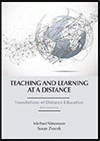
Teaching and Learning at a Distance
Foundations of Distance Education 8th Edition
By:
Michael Simonson, Nova Southeastern University
Susan Zvacek, CollegeTeachingCoach.com
Published 2024
Teaching and Learning at a Distance is written for introductory distance education courses for preservice or in-service teachers, and for training programs that discuss teaching distant learners or managing distance education systems. This text provides readers with the basic information needed to be knowledgeable distance educators and leaders of distance education programs. The teacher or trainer who uses this book will be able to design courses, evaluate programs, and identify issues and trends affecting the field.
In this text we take the following themes:
The first theme is the definition of distance education. Before we started writing the first edition of Teaching and Learning at a Distance we carefully reviewed the literature to determine the definition that would be at the foundation of our writing. This definition is based on the work of Desmond Keegan, but is unique to this book and has been adopted by the Association for Educational Communications and Technology and by the Encyclopedia Britannica.
The second theme of the book is the importance of research to the development of effective courses and programs offered at a distance. The best practices presented in Teaching and Learning at a Distance are validated by scientific evidence. Certainly there are “rules of thumb,” but we have always attempted to only include recommendations that can be supported by research.
The third theme of Teaching and Learning at a Distance is derived from Richard Clark’s famous quote published in the Review of Educational Research asserting that media are mere vehicles that do not directly influence achievement. Clark’s controversial work is discussed in the book, but is also fundamental to the book’s advocacy for distance education—in other words, we authors do not make the claim that education delivered at a distance is inherently better than other ways people learn. Distance delivered instruction is not a magical approach that makes learners achieve more.
Equivalency theory is the fourth theme of the book. Here we present the concept that instruction should be provided to learners that is equivalent rather than identical to what might be delivered in a traditional environment. Equivalency theory helps the instructional designer approach the development of instruction for each learner without attempting to duplicate what happens in a face-to-face classroom.
The final theme for Teaching and Learning at a Distance is the idea that the book should be comprehensive—that it should cover as much of the various ways instruction is made available to distant learners as is possible. It can serve as a stand-alone source of information.
CONTENTS
PART I: FOUNDATIONS. CHAPTER 1: Foundations of Distance Education. CHAPTER 2: Definitions, History, and Theories of Distance Education. CHAPTER 3: Research and Distance Education. CHAPTER 4: Technologies, the Internet, and Distance Education. PART II: TEACHING AND LEARNING AT A DISTANCE. CHAPTER 5: Instructional Design for Distance Education. CHAPTER 6: Teaching and Distance Education. CHAPTER 7: The Student and Distance Education. CHAPTER 8: Support Materials and Visualization for Distance Education. CHAPTER 9: Assessment for Distance Education. PART III: MANAGING AND EVALUATING DISTANCE EDUCATION. CHAPTER 10: Intellectual Property: Ownership, Distribution, and Use. CHAPTER 11: Managing and Leading a Distance Education Organization. CHAPTER 12: Evaluating Teaching and Learning at a Distance. Index.
-
Paperback979-8-88730-511-0
Web price: $45.04 (Reg. 52.99)
-
Hardcover979-8-88730-512-7
Web price: $80.74 (Reg. 94.99)
- eBook979-8-88730-513-4

- EDU041000 - EDUCATION: Distance & Online Education
- EDU053000 - EDUCATION: Training & Certification
- EDU021000 - EDUCATION: Non-Formal Education
-
 A Practical Guide to Exemplary Professional Development Schools
A Practical Guide to Exemplary Professional Development Schools
-
 Beyond Single Stories
Changing Narratives for a Changing World
Beyond Single Stories
Changing Narratives for a Changing World
-
 Contemporary Perspectives on English as a Medium of Instruction
Contemporary Perspectives on English as a Medium of Instruction
-
 Effective Alternative Assessment Practices in Higher Education
Effective Alternative Assessment Practices in Higher Education
-
 Professional Learning Journeys of Teacher Educators
Professional Learning Journeys of Teacher Educators
-
 The AMTE Handbook of Mathematics Teacher Education
Reflection on Past, Present and Future – Paving the Way for the Future of Mathematics Teacher Education, Volume 5
The AMTE Handbook of Mathematics Teacher Education
Reflection on Past, Present and Future – Paving the Way for the Future of Mathematics Teacher Education, Volume 5
-
 The Handbook for Aspiring Higher Education Leaders
The Handbook for Aspiring Higher Education Leaders

